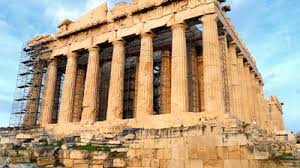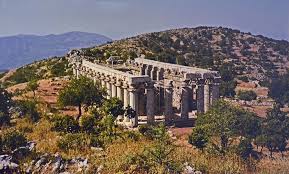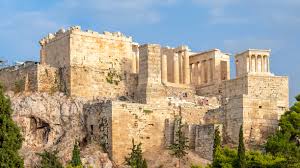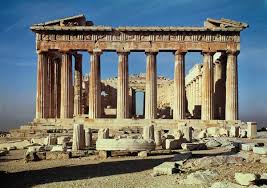
In my small walk through antiquity. I wanted to further look into the architectural designs of the Classic world. When we think of classical Greek architecture, one structure invariably comes to mind: the Parthenon. This iconic temple, perched atop the Acropolis in Athens, stands as a testament to the ingenuity, artistry, and vision of its architects, Ictinus and Callicrates. Though their names may not be as widely recognized as some of history’s other great architects, their contributions to the world of art and design are nothing short of monumental. Travel with me to the ancient past as we delve into the lives, works, and enduring influence of these two master builders of ancient Greece.
Who Were Ictinus and Callicrates?
Ictinus and Callicrates were Athenian architects who flourished during the 5th century BCE, a period often referred to as the Golden Age of Athens. This era, under the leadership of Pericles, saw an unprecedented flourishing of art, philosophy, and architecture. While little is known about their personal lives, their professional achievements have left an indelible mark on the history of architecture.
Ictinus is often described as the more visionary of the two, credited with designing some of the most sophisticated structures of his time. Callicrates, on the other hand, was known for his precision and technical expertise. Together, they formed a partnership that combined creativity and craftsmanship, resulting in buildings that were not only functional but also deeply symbolic and aesthetically groundbreaking.
The Parthenon: A Masterpiece of Classical Design

The crowning achievement of Ictinus and Callicrates is undoubtedly the Parthenon, a temple dedicated to Athena Parthenos, the patron goddess of Athens. Constructed between 447 and 432 BCE, the Parthenon is widely regarded as the pinnacle of Doric architecture, though it also incorporates Ionic elements, showcasing the architects’ ability to blend styles seamlessly.
Key Architectural Features of the Parthenon
- Optical Illusions and Refinements
One of the most remarkable aspects of the Parthenon is its use of subtle optical refinements to create a sense of perfection. The columns are slightly curved (a technique known as entasis) to counteract the optical illusion of sagging, and the stylobate (the platform on which the columns stand) is gently convex. These refinements demonstrate the architects’ deep understanding of human perception and their commitment to achieving visual harmony. - Proportional Harmony
The Parthenon is a masterpiece of mathematical precision. Its design is based on the golden ratio, a proportion often associated with beauty and balance. The temple’s dimensions and the spacing of its columns were carefully calculated to create a sense of order and symmetry. - Sculptural Integration
The Parthenon is not just an architectural marvel; it is also a showcase of sculptural artistry. The metopes, frieze, and pediments are adorned with intricate carvings depicting mythological scenes and religious processions. These sculptures were integral to the building’s design, reflecting the architects’ holistic approach to art and architecture.
Other Works by Ictinus and Callicrates
While the Parthenon is their most famous collaboration, Ictinus and Callicrates were involved in other significant projects:

- The Temple of Apollo Epicurius at Bassae
Located in the remote mountains of Arcadia, this temple is another masterpiece attributed to Ictinus. It is notable for its unique combination of Doric, Ionic, and Corinthian elements, as well as its innovative use of a Corinthian column inside the cella (the inner chamber of the temple). This temple is often considered a precursor to the more ornate styles of later Greek and Roman architecture. - The Telesterion at Eleusis
This large hall, used for the Eleusinian Mysteries (a series of secret religious rites), is another project linked to Ictinus. Although the structure has been largely destroyed, its design is believed to have been groundbreaking for its time, featuring a complex arrangement of columns to support a massive roof. - The Long Walls of Athens
Callicrates is credited with overseeing the construction of the Long Walls, which connected Athens to its port at Piraeus. These fortifications played a crucial role in the city’s defense during the Peloponnesian War.
The Enduring Influence of Ictinus and Callicrates

The work of Ictinus and Callicrates has had a profound and lasting impact on the world of architecture. Their emphasis on proportion, harmony, and the integration of art and architecture set a standard that would influence countless architects in the centuries to come. The Parthenon, in particular, has served as a source of inspiration for neoclassical architects during the 18th and 19th centuries, with its design elements being replicated in buildings such as the British Museum in London and the United States Capitol in Washington, D.C.
Moreover, their innovative use of optical refinements and their ability to blend different architectural styles have made their work a subject of study for architects and art historians alike. The Parthenon remains a symbol of the cultural and intellectual achievements of ancient Greece, and its enduring appeal is a testament to the genius of its creators.
Conclusion: Celebrating the Masters of Classical Architecture

Ictinus and Callicrates were more than just architects; they were visionaries who understood the power of architecture to inspire, uplift, and communicate cultural values. Their work transcends time, continuing to captivate and inspire us more than two millennia after it was created. As we marvel at the Parthenon and other structures they designed, we are reminded of the enduring power of art and architecture to connect us to our shared human heritage.
In a world where architecture often prioritizes functionality over beauty, the legacy of Ictinus and Callicrates serves as a reminder of the importance of striving for both. Their work challenges us to think beyond the practical and to create spaces that elevate the human spirit—a lesson as relevant today as it was in ancient Greece.
Thanks for reading! About me
What are your thoughts on the architectural achievements of Ictinus and Callicrates? Have you ever visited the Parthenon or seen a building inspired by their work? Share your experiences and insights in the comments below!




